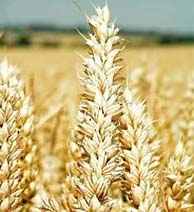Mercantile wheat

Wheat is the most important kind of cereals, by its spread, production, spending, nutritious value, but by at international trade. Wheat bean consists of three wrappers ( shells ) endosperm and seed-bud. Chemical composition of wheat varies. At average, wheat bean contains around 70% carbohydrates, 11% of raw proteins, 3% of celluloses 1,75% of fats and around 1,7% of mineral materials. Wheat contains very important components, such as vitamins from group B, A and PP, and minerals-iron, callium (kalium) calcium, Magnesium , mangane (mangan) and selen.
The usage: Wheat as the most important agricultural , it has its usage value as a technological raw material for production of flower, bread, rolls and paste, and so on..
Moisture: Moistness of wheat varies depending on the degree of ripeness of wheat, the way of sowing , air density at the time and after harvest. Under content of moisture it is understood loss of mass which wheat is subject to under certain conditions, established by a standard method. Wheat with moisture above 15 cannot come to the market, because it is subject of bio chemical deviations.
Storing conditions: Moisture and temperature must be controlled at all times, in order to establish certain handling of wheat, which basically narrow down to drying and ventilation. One has to ensure a good circulation of air, as well as to provide that air is dryer than the wheat bean. Density of air in a storage must not be higher than 12% and temperature not higher than 8 C.
Transportation requirements: Basic conditions for all means of transportation, regardless whether bean products an bulk or packed at begs or other kind of packing, are: that they are accurate, that they are clean and dry, that they are without external smells and strong smells in genera, that they are without remains of beans and remains of the previous material transported and that they are protected of rain and making it wet in general.
Minimal conditions of quality according to JUS: Content of water: at most 15%, hectoliter mass at least 74 kg, quantity of aggregate admixtures at most 8%. Wheat, which does not meet even minimal conditions of quality, is treated as good, which is not in accordance with JUS.
Producer, who brings wheat into turnover is obliged to provide with a report of analysis performed, i.e. quality established, which must contain sign (number) of results, information of sort of wheat, information of quantity of water, information of hectoliter mass and information about single and aggregate quantity of admixtures.
Based on proteins content, sedimentation values and sorts, wheat is apportioned into I, II and III class of quality. The wheat, which contains below 10% of raw proteins and 18% of sedimentation value does not meet conditions of any


